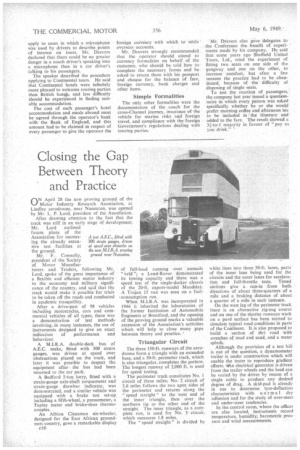Closing the Gap Between Theory and Practice
Page 16

If you've noticed an error in this article please click here to report it so we can fix it.
ON April 28 the new proving ground of the Motor Industry Research Association, at Lindley aerodrome, near Nuneaton, was opened by Mr. L. P. Lord, president of the Assodiation.
After drawing attention to the fact that the track was stilt in an early stage of development. Mr. Lord outlined future plans of the
Association for increasA lest A.E.C., fitted with
ing the already exten300 strain gauges, driven sive test facilities at at speed over obstacles on the ground, the new proving Mr. F.. Connolly, ground near Nuneaton. president of the Society of Motor Manufac turers and Traders, following Mr. Lord, spoke of the great importance of a flexible and efficient motor industry to the economy and military significance of the country, and said that the track would make it possible for trials to be taken off the roads and conducted in academic tranquillity.
After a drive-past of 98 vehicles including motorcycles, cars and commercial vehicles of all types, there was a demonstration of test methods involving, in many instances, the use of instruments designed to give an exact indication of performance and behaviour.
A IVLI.R.A. double-deck bus of A.E.C. make, fitted with 300 strain gauges, was driven at speed over obstructions placed on the track, and later it was possible to inspect the equipment after the bus had been returned to the car park.
A Bedford 5-ton lorry, fitted with a strain-gauge axle-shaft torquemeter and strain-gauge drawbar indicator, was demonstrated, and a similar vehicle was equipped with a brake test set-up including a fifth-wheel, a pressometer, Tapley meter and brake-shoe thermocouples.
An Albion Clansman six-wheeler, designed for the East African groundnuts country, gave a remarkable display c10 of full-load running over unmade "veld "; a Land-Rover demonstrated its towing capacity and there was a speed test of the single-decker chassis of the 20-ft. export-model Maudslay. A Trojan 15 van was seen on a fuel'consumption run.
When M.I.R.A. was incorporated in 1946 it inherited the laboratories of the former Institution of Automobile Engineers at Brentford, and the opening of the proving ground marks a valuable extension of the Association's activities which will help to close many gaps between theory and practice. •
Triangular Circuit
The three 150-ft. runways of the aerodrome form a triangle with an extended base, and a 50-ft. perimeter track, which is also triangular, completes the pattern. The longest runway of 2,000 ft. is used for speed testing. The perimeter track constitutes No. 1 circuit of three miles; No. 2 circuit of 3.6 miles follows the two apex sides of the perimeter and returns along the "speed straight" to the west end of the inner triangle, then over the northern tip tothe other end of the straight. The inner triangle, as a complete run, is used for No. 3' circuit, which measures 1.8 miles.
The "speed straight" is divided by white lines into three 50-ft. lanes, parts of the inner lane being used for the circuits and the outer lanes for acceleration and full-throttle tests. Timed sections give a run-in from both directions of about three-quarters of a mile and a braking distance of about a quarter of a mile in each instance.
On the west leg of the perimeter track there is an alternative zig-zag course and on one of the shorter runways work on a pave surface ha,s been started to simulate typical road conditions in parts of the Continent. It is also proposed to build a section of dirt road with stretches of mud and sand, and a water splash.
Although the provision of a test hill is out of the question, a dynamometer trailer is under construction which will enable the tester to reproduce gradient effects. *An electrical generator is driven from the trailer wheels and the load can be varied by the driver by means of a single cable to produce any desired degree of drag. A skid-pad is already in use to determine tyre-deflection characteristics with normal dry adhesion and for the study of over-steer and under-steer tendencies.
In the control room, where the offices are also located, instruments record temperature, humidity, barometric pressure and wind measurements.




























